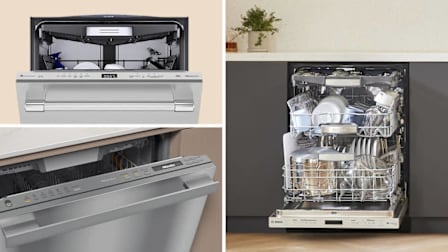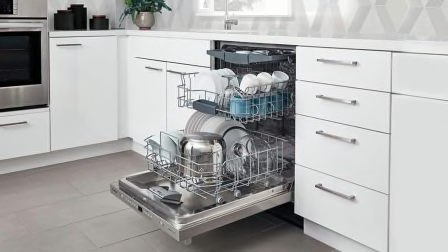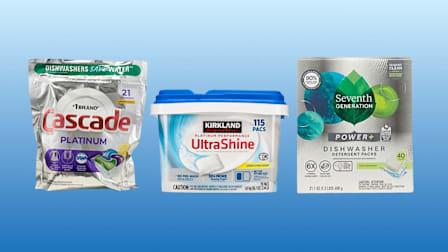How to Get the Most Out of Your Water-Saving Dishwasher
If your dishwasher can’t seem to clean, consider these five potential causes and how best to fix them
When you shop through retailer links on our site, we may earn affiliate commissions. 100% of the fees we collect are used to support our nonprofit mission. Learn more.

Household appliances across the board have become more energy-efficient over the years—and that extends to water usage too. Dishwashers, for one, are more water-efficient than they’ve ever been. But when you’re dealing with a dishwasher that fails to clean your dishes thoroughly, you may wonder if using less water is the problem.
Federal regulations for residential dishwashers date back to the 1970s, though it wasn’t until this century that there was an obvious change in how dishwashers worked: In 2010, phosphates, key cleaning agents in early dishwasher detergents, were largely removed from popular detergents because of their environmental impact. And dishwashers sold since 2013 can use no more than 5 gallons to wash a load of dishes, as measured by a standardized test. In the real world, that translates to 3 to 6 gallons of water per cycle, according to our tests, but either way it’s less water than almost any hand-washing technique. Older dishwashers used to use around 10 gallons per load.
These new rules forced appliance makers to rethink how they made their dishwashers. Some brands didn’t miss a beat and continued to produce high-performing dishwashers that made most of their owners happy. However, better water efficiency has meant longer cycles in some machines, which can be frustrating for dishwasher owners accustomed to shorter cycles. And some people have found that modern machines just don’t work as well as their old dishwasher did—at least one survey found that 75 percent of respondents said they prerinse their dishes.
What CR's Tests Reveal About Water-Saving Dishwashers
In our extensive lab testing, CR has found no clear relationship between a machine’s water use and cleaning performance: Some of the thirstiest dishwashers earn weak ratings in our washing test, while many highly efficient models earn top marks.
Reasons Your Dishwasher Can't Seem to Clean
Some people prerinse dishes out of habit, because their parents did, or because they used to with their old machine. If that is you, then at least try to skip the prerinse to see what happens—you have nothing to lose. If your dishes indeed come out dirty, here are possible offenders, and what to do about them.
A clogged filter: This can restrict the water flow in your dishwasher, so cleaning it should give the machine a performance boost. If your dishwasher has a removable filter (as most do), pop it out and rinse it under the faucet. Try to do this at least a few times per year, or whenever you notice a drop in your dishwasher’s performance.
Food and mineral deposits: These naturally accumulate throughout the system. To break them up, run a self-cleaning cycle: Leave the racks empty, add some powdered citric acid or a dishwasher cleaner, and run a heavy cycle. It’s wise to do this once a year, or whenever you notice chalky residue forming on the walls of your dishwasher.
An underperforming prewash cycle: Most dishwashers start loads by spraying tap-temperature water for 15 minutes to knock away loose soils before opening the detergent tray and turning on the water heaters. You can make more out of the prewash portion—and boost the overall cleaning performance—by adding a microdose of powder or a spurt of gel detergent outside of the detergent door. Many dishwashers have a small notch on the detergent tray for this purpose, but you can also just add the dose directly to the bottom of the tub.
A subpar detergent: Detergents with enzymes in their formulas tend to outperform detergents without enzymes. (Most detergents do have them now, and it’ll usually say so somewhere on the packaging.) Beyond checking for that basic ingredient, browse CR’s dishwasher detergent ratings to see the top performers and how more than 20 popular formulas handled our tough tests. Consider using a rinse aid too.
Hard water: Hard water makes detergent less effective, so try softening it. Assuming you don’t have a whole-house softening system or a dishwasher with a compartment for softening salts or even built-in water softener, you could try using a hard-water “booster” product, or adding a small scoop of citric acid (the main ingredient in those boosters) to the dishwasher tub or detergent tray.
What to Do If Your Dishwasher Is, in Fact, the Problem
If you try all those steps and you still end up with dirty dishes . . . well, you’re out of options. Some dishwashers just don’t clean well, especially once they get to be a few years old. But remember, it’s not because they skimp on water—dishwashers can be lousy for a number of other reasons.
If you’re stuck with a subpar performer, there may be no escaping the prerinse. While CR generally recommends skipping the prerinse, some people with a poor-performing dishwasher have no other practical choice. To save water, preclean dishes by dipping them into a basin filled with a modest amount of cold water as opposed to running the water in your sink.
Water-Saving Dishwashers With Cleaning Power
Next time you buy a dishwasher, focus on getting one that can wash really well, because then you’ll be able to skip the prerinse—saving you time, money, and stress. You’ll find that most of the top performers in our ratings are Energy Star certified—a designation from the Department of Energy and the Environmental Protection Agency given to dishwashers that meet a certain standard for water and energy efficiency. CR members can also find dishwashers that earn our Green Choice designation for sustainability: These are dishwashers save water and energy, and their manufacturing, materials, and shipping take a minimal toll on the environment.
Larry Ciufo, CR’s head of dishwasher testing, made a $100 bet with his mom that if she bought one of CR’s top-ranked dishwashers instead of a mediocre discounted model, she wouldn’t have to prerinse anymore. He said he’d even hand-wash any dirty dishes if the new model failed to clean properly. She bought the better performer, and now her dishes come out clean every time without any prerinsing. “I won the bet—but I took a homemade dinner instead of the money,” Ciufo says.
Here are a few of our top overall performers with great energy efficiency that you might consider next time you’re shopping for a dishwasher.
































